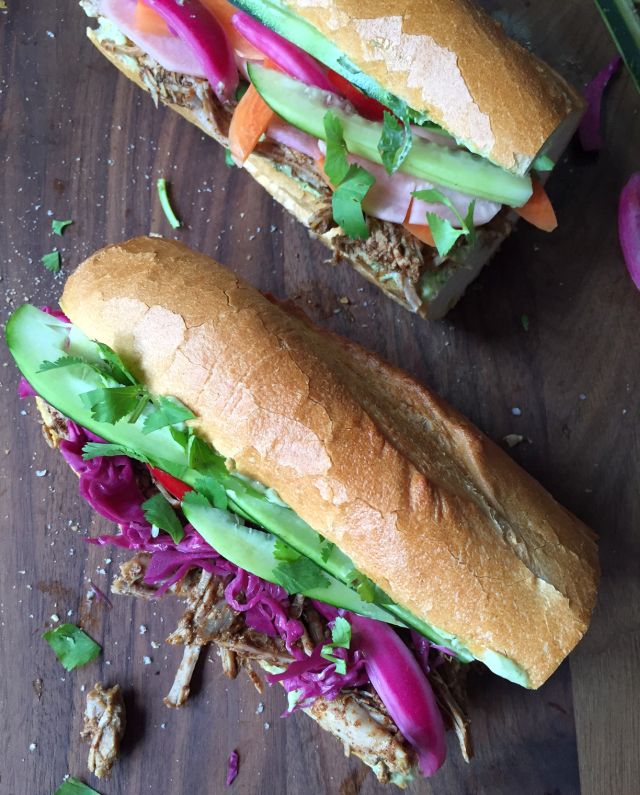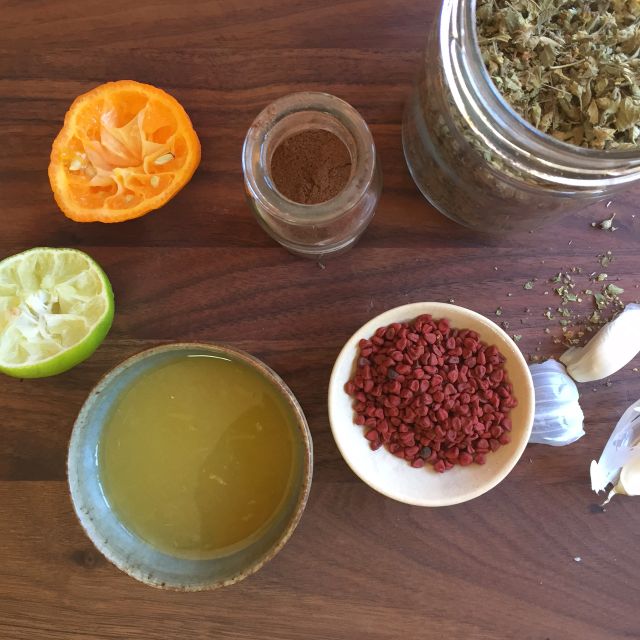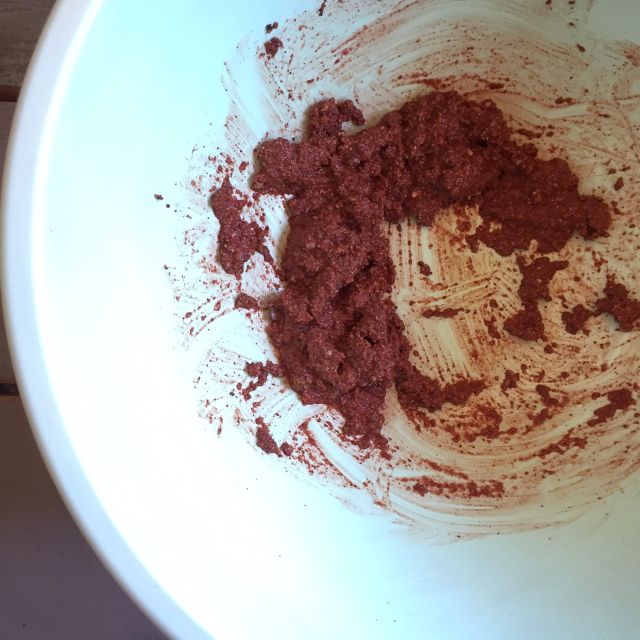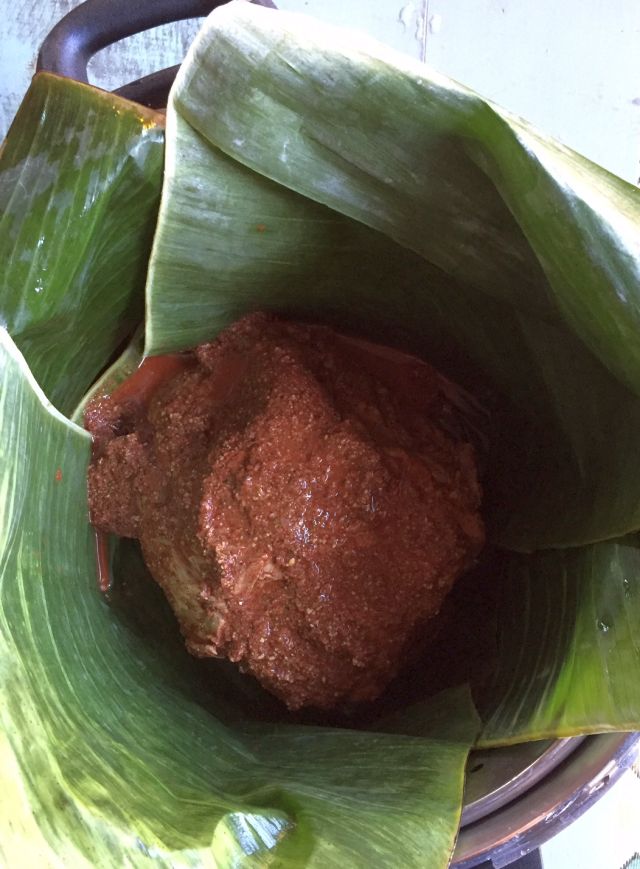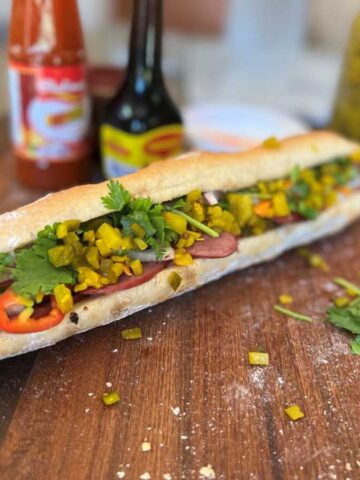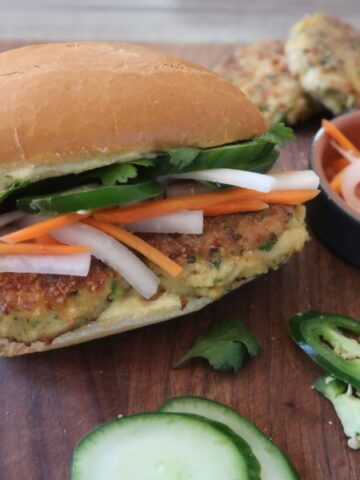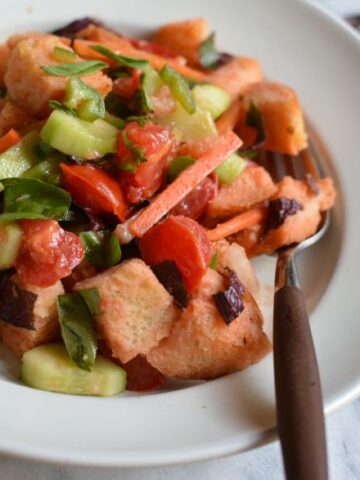At a party a few weeks ago, I was introduced to Ricardo Cervantes, the CEO and founder of La Monarca, a small chain of Mexican bakeries in the Los Angeles area. I revealed to him that I’m somewhat obsessed with bolillo rolls because they’re great for banh mi. He was not fully familiar with banh mi so I described them as la torta Vietnamita. Does La Monarca make and sell bolillo rolls? Yes, Ricardo said. Then just add mayonesa, jugo de Maggi, carne, escabeche, jalapeño, pepino, y cilantro. We giggle and he asked what kind of carne should they use.
Many kinds of meat would work. I’ve made banh mi with carnitas and carne asada. Since Mexicans also share a love of leche condensada, make café Vietnamita, I suggested to Ricardo. La Monarca should it with a torta Vietnamita for a special cross-cultural treat to customers. We laughed all through the conversation and Ricardo turned to our mutual friend, Paola, and said, “I like her!”
I am good with offering ideas to people, as you know. Soon after, I made a batch of Yucatecan pork pibil from one of a favorite Rick Bayless cookbook. Restaurants seldom make it well and it can be watery tasting. The pork is traditionally marinated in a tangy, spicy mixture featuring achiote/anatto seeds (hot dieu mau in Vietnamese). Then it’s wrapped in banana leaves and slow cooked. The pork steams in the marinade and its juices.
Short on time, I decided to steam the pork in a pressure cooker instead of roasting it as Bayless suggested. I figured that the flavors would remain in the banana leaf since the package was suspended above the water. Plus, I could cook it in less than 45 minutes instead of the 2 to 3- hour roasting.
Pressure cookers don’t work well on everything but once in a while, it produces results that are very close to what you’d get with regular, traditional cooking methods. This was one of them.
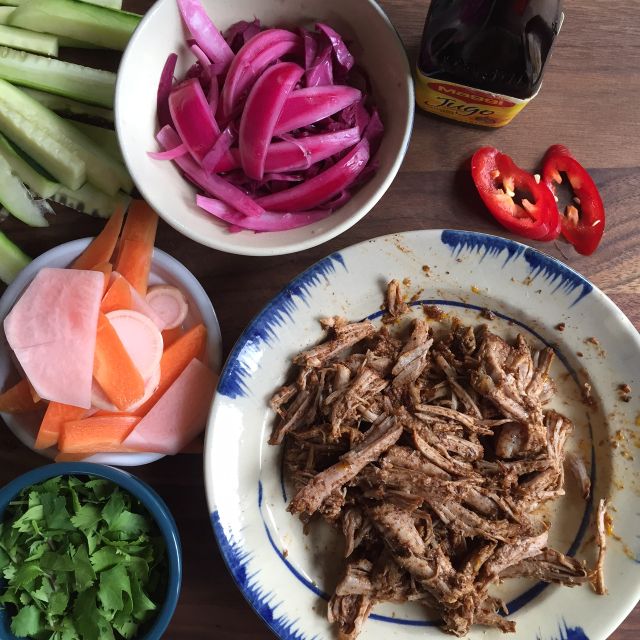
The pork was fork tender after 40 minutes of cooking in my Fagor Duo cooker. The flavor was fabulous. We used some for tacos and the rest for banh mi. (I used a light, French-style baguette from the supermarket since the bolillos were all gone.)
Pork pibil is typically served with a red onion pickle. My short cut was to use the brine from one of my banh mi pickles. The citrusy red cabbage pickle (see page 34 of The Banh Mi Handbook for the recipe) was perfect, as was the daikon and carrot pickle. I also whipped up a batch of cilantro Maggi mayonnaise (recipe on page 27 of the banh mi book), which include a little jalapeno (or serrano) for pepper appeal.
The torta Vietnamita was fabulous. The beauty of pork pibil is you can make it days in advance. Keep the meat intact and shred it up before you eat it. Remember to save the cooking juices, which are loaded with flavor. Add salt at the end because the pork always seems to need a little extra oomph.
RECIPE
Pork Pibil Banh Mi
Enough for 5 or 6 banh mi sandwiches
Ingredients
- 1 ½ tablespoons achiote (annatto) seeds
- Rounded 1 teaspoon dried oregano leaves
- 1 ½ teaspoons ground allspice
- 1 teaspoon pepper
- 2 tablespoons plus 1 teaspoon cider vinegar
- 3 large cloves garlic, finely chopped and crushed with a knife or put through a press
- ¾ teaspoon fine sea salt, plus more as needed
- ¼ cup (60 ml) fresh lime juice plus 2 tablespoons fresh orange juice, or 6 tablespoons sour orange juice
- Generous 1 ½ pounds (675 g) boneless pork shoulder
- 1 very small red onion, halved and cut along the grain into thin wedges
- Brine from a banh mi pickle, such as the citrusy red cabbage pickle (see the recipe on page 34 of The Banh Mi Handbook)
- Two 12-by-18 inch (30 x 45 cm) pieces thawed or fresh banana leaves, or parchment paper
Instructions
- Use an electric spice grinder or coffee grinder dedicated to grinding spices to render the achiote and oregano into fine texture. Transfer to a bowl and add the allspice, pepper, vinegar, garlic, and salt. Work in 1 to 2 tablespoons of water to make a paste. Then stir in the citrus juice to create a marinade.
- Add the pork then smear and rub it into the flesh. Make sure it gets into all the crevices. Cover and chill at least 2 hours or overnight. Return to room temperature before moving on.
- Meanwhile, put the onion in a small bowl and add the brine from the banh mi pickle to cover. Or, just put the onion into the jar with the banh mi pickle. Let sit for 2 hours or overnight to pickle the onion.
- To steam in a pressure cooker, put about ¾ inch (2 cm) of water in the bottom of a 6- or 8-quart (6 or 8 l) pressure cooker. Add the little goodie to raise the steamer, as needed or instructed by your pressure cooker. Line the steamer insert with the banana leaves, arranging them like a cross. Put the pork in the center, and add all the marinade. Fold the banana leaves to enclose the pork. Set the steamer in the pressure cooker.
- Bring to high pressure (15 psi) and adjust the heat to maintain pressure, indicated by a steady stream or steam coming out of the valve. Cook for 40 minutes, then slide to a cool burner and let depressurize naturally. Remove the lid, tilting it away from you. Let cool for about 10 minutes, before lifting up the steamer insert and placing it on a plate.
- Transfer the pork to a bowl and use two forks (or your fingers) to shred the meat. Add all the juices and season with salt. Cover to keep warm and use to make banh mi with the usual suspects – a light crisp roll or section of baguette, mayonnaise, Maggi, the pork, pickle, jalapeño or Fresno chile slices, cucumber, and cilantro.
Note: if you don’t have a pressure cooker, use a 4 to 6-quart (4 to 6 l) oven safe pot. Line it with the banana leaves, add the pork and marinade, then close up the leaves. Pour in about 1 cup of water. Then bake in a preheated 325F (160C) oven for 2 ½ to 3 hours, checking 2 or 3 times to make sure there is enough water to keep the pork moist. The pork is done when it’s fork tender.
Another recipe to try: Dashi carnitas recipe (add a Japanese-Mexican twist to your torta Vietnamita)













